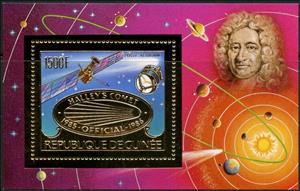Souvenir Sheet: Halley's Comet (Guinea 1986)
Halley's Comet (Guinea 1986)
01 July (Guinea ) within release Halley's Comet 1985 - 1986 goes into circulation Souvenir Sheet Halley's Comet face value 1,500 Guinean franc
| Souvenir Sheet Halley's Comet in catalogues | |
|---|---|
| Michel: | Mi: GN BL219A |
| Yvert et Tellier: | Yt: GN BF203 |
Souvenir Sheet is horizontal format.
No Sn codeAlso in the issue Halley's Comet 1985 - 1986:
- Stamp - Sir Edmund Halley face value 1,500;
- Souvenir Sheet - Edmund Halley face value 600;
- Stamp - Halley's Comet face value 1,500;
- Stamp - Edmund Halley face value 600;
- Stamp - Tapisserie of Bayeux (1066) face value 5;
- Stamp - The Comet above Mexico face value 40;
- Stamp - Edmond Halley an Issac Newton face value 300;
- Stamp - Edmond Halley (1656-1742) face value 50;
- Stamp - The Comet above Arabia face value 30;
- Souvenir Sheet - Edmund Halley face value 600;
- Souvenir Sheet - Halley's Comet face value 1,500;
- Stamp - The Comet and Space Probes face value 500;
- Souvenir Sheet - Sir Edmund Halley face value 1,500;
- Stamp - Edmond Halley (1656-1742) face value 50;
- Souvenir Sheet - Edmond Halley (1656-1742) face value 50;
- Souvenir Sheet - Edmond Halley (1656-1742) face value 50;
- Stamp - Edmond Halley and Issac Newton face value 300;
- Souvenir Sheet - Edmond Halley and Issac Newton face value 300;
- Souvenir Sheet - Edmond Halley and Issac Newton face value 300;
- Mini Sheet - Halley's Comet face value 925;
- Stamp - Halley's Comet face value 1,500;
- Souvenir Sheet - Halley's Comet face value 1,500;
- Souvenir Sheet - Sir Edmund Halley face value 1,500;
- Stamp - Tapisserie of Bayeux (1066) face value 5;
- Souvenir Sheet - Tapisserie of Bayeux (1066) face value 5;
- Souvenir Sheet - Tapisserie of Bayeux (1066) face value 5;
- Stamp - The Comet above Arabia face value 30;
- Souvenir Sheet - The Comet above Arabia face value 30;
- Souvenir Sheet - The Comet above Arabia face value 30;
- Stamp - The Comet above Mexico face value 40;
- Souvenir Sheet - The Comet above Mexico face value 40;
- Souvenir Sheet - The Comet above Mexico face value 40;
- Stamp - The Comet and Space Probes face value 500;
- Souvenir Sheet - The Comet and Space Probes face value 500;
- Souvenir Sheet - The Comet and Space Probes face value 500;
Souvenir Sheet Halley's Comet it reflects the thematic directions:
A comet is an icy, small Solar System body that warms and begins to release gases when passing close to the Sun, a process called outgassing. This produces an extended, gravitationally unbound atmosphere or coma surrounding the nucleus, and sometimes a tail of gas and dust gas blown out from the coma. These phenomena are due to the effects of solar radiation and the outstreaming solar wind plasma acting upon the nucleus of the comet. Comet nuclei range from a few hundred meters to tens of kilometers across and are composed of loose collections of ice, dust, and small rocky particles. The coma may be up to 15 times Earth's diameter, while the tail may stretch beyond one astronomical unit. If sufficiently close and bright, a comet may be seen from Earth without the aid of a telescope and can subtend an arc of up to 30° (60 Moons) across the sky. Comets have been observed and recorded since ancient times by many cultures and religions.
Outer space (or simply space) is the expanse that exists beyond Earth's atmosphere and between celestial bodies. It contains ultra-low levels of particle densities, constituting a near-perfect vacuum of predominantly hydrogen and helium plasma, permeated by electromagnetic radiation, cosmic rays, neutrinos, magnetic fields and dust. The baseline temperature of outer space, as set by the background radiation from the Big Bang, is 2.7 kelvins (−270 °C; −455 °F)
A spacecraft is a vehicle that is designed to fly and operate in outer space. Spacecraft are used for a variety of purposes, including communications, Earth observation, meteorology, navigation, space colonization, planetary exploration, and transportation of humans and cargo. All spacecraft except single-stage-to-orbit vehicles cannot get into space on their own, and require a launch vehicle (carrier rocket).



